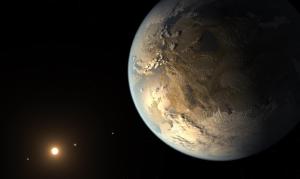Blog
Seasons of Time
6 July 2018
 NASA Ames/JPL-Caltech/T. Pyle
NASA Ames/JPL-Caltech/T. PyleEarth is the only planet in the universe known to harbor life. Earth’s orbital distance from the Sun ensures that it is not too hot, not too cold, and able to have liquid water on its surface. In other words, Earth lies within the Sun’s habitable zone. We’ve discovered many exoplanets within the habitable zones of their respective stars, making them potentially habitable. But temperature isn’t the only requirement for life. Mars, and Venus are also in the Sun’s habitable zone, but are not lush living worlds. Part of the reason for that is the variation of seasons over time.
Seasons are caused by the tilt of a planet’s rotational axis relative to its orbital plane, known as obliquity. Earth, for example, has an obliquity of about 23.5 degrees, while Mars has an obliquity of about 25 degrees. So both Earth and Mars experience similar seasons. But the axial tilt of Mars isn’t stable over time. Over millions of years the Martian obliquity has varied from zero degrees to almost 60 degrees. This is because Mars interacts gravitationally with Earth and other planets in the inner solar system, and those little gravitational tugs cause the tilt of Mars to change over time. The same thing would happen to Earth were it not for the Moon. The gravitational tug of the Moon on Earth helps keep its obliquity stable, so it only varies between 22 degrees to 25 degrees. Earth has had pretty stable seasons over millions of years, while the instability of the Martian seasons has caused much of its surface water to evaporate, leaving it baren and dry.
For exoplanets, a similar effect could occur. Planets in the habitable zone would likely experience gravitational tugs from sibling planets, and that could make their seasons unstable. If a planet needs a large moon to keep its seasons stable, then life is probably very, very rare. Earth has the largest moon in the solar system, relative to its size, and most exoplanets wouldn’t have such a companion. But a recent study has shown that exoplanets don’t need a large moon to have stable seasons.
Using computer simulations, a team analyzed the motion of two exoplanets, Kepler-62f and Kepler-186f.1 These exoplanets are a bit more massive than Earth, and each orbit in their star’s habitable zone. Both systems also have at least five exoplanets, similar to the inner solar system. They assumed the rotation of these planets was similar to Earth (about a day), and calculated how the gravitational tugs of their siblings affected axial tilt. They found that the obliquity of the planets could remain fairly stable over millions of years, and that would mean stable or slowly changing seasons. This held true even if the exoplanets don’t have a large moon.
This doesn’t mean that either exoplanet has life, but it does show that planets don’t need a large moon to have stable seasons. And that means the possibility of extraterrestrial life is a bit better than we feared.
Shan, Yutong, and Gongjie Li. “Obliquity Variations of Habitable Zone Planets Kepler-62f and Kepler-186f.” The Astronomical Journal 155.6 (2018): 237. ↩︎